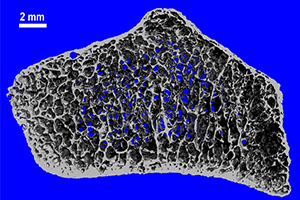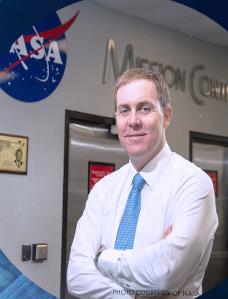Your Bones in Space
Dr. Steven Boyd, P.Eng., finds himself examining the most sophisticated structures, pinpointing their strengths and weaknesses, their changes over time and environment. Structures possessing an electrical grid, a plumbing system, and most important to his studies, an intricate internal framework holding everything in place. He didn’t want to construct buildings or bridges—that wasn’t his thing.
Dr. Boyd studies bones and joints in the human body, and his most fascinating subjects are those that have returned from outer space.
A biomedical engineer's research supports future space travel
Initially, he wanted to pursue political science, but now he cites biomedical engineering as a very good fit. “I always joke the further I tried to get away from engineering, the deeper I got into it.” If he had known he’d be delving into the mysteries of space travel—a modern day Marco Polo of bone structure in space—perhaps he would have embraced his natural math and science talents sooner.
He now shares those talents with other researchers at the University of Calgary’s Schulich School of Engineering and Cummings School of Medicine, where his research on bones and joints meets his goal—to directly impact human health.
In 2020, Dr. Boyd concluded a six-year study in partnership with the Canadian Space Agency. As part of a multidisciplinary team, he researched the effects of weightlessness and space travel on the bone architecture and structure of 17 astronauts. Two of the astronauts were from Canada and the rest harkened from the United States, Japan, Italy, and France.
Just before the astronauts left on their mission, Dr. Boyd met them at the Johnson Space Center in Houston. Each one complete a questionnaire before their bones were scanned using a machine brought in from the University of Calgary. The hour-long process was repeated within days of their return to Earth, and six and 12 months later.
The Eiffel Tower in your body

When the study was completed, Dr. Boyd felt relieved. “It’s been known for a long time that people lose bone density in a weightless environment like space. It usually takes at least a month or two before you have noticeable bone loss. The missions in the space shuttle, which usually last two weeks, weren’t really a major issue for bone, but six-month-long missions—that’s a long time to be weightless.”
Measuring areal bone mineral density (how much bone you have per unit area) tells how much of the material is bone, and comparing pre- and post-flight densities enables Dr. Boyd to easily determine what was lost and how much was regained after the astronaut’s return and recovery. But that’s not the whole story—he says there are challenges in quantifying the changes in the bones.
“In reality, bones are not a homogenous material—they’re a structure. At the very high resolution we measure bone, you can see all these interactions, all these detailed little structures. When you measure bone loss and bone density, what’s happening is it’s eroding the bone surface and you’re losing bone mass, but at the structural level, it means the connections are being disconnected.” The singular structures creating strength within the bones thin until they’re in two disconnected pieces, like delicate white stalagmite and stalactites in a cave, attached to the roof and floor and coming to separate points, just moments from touching.
Dr. Boyd says from a mechanical view, it’s like the Eiffel tower, which he explains is not made from solid steel, but interconnected rods that give strength. “If you took away a bunch of the struts, it would get weaker. When you lose bone, you’re eroding those rods. When they erode, they no longer have a connection—they get thinner and thinner until they’re gone, which obviously has a big impact on the strength of the bone.”
The imaging equipment used in the study measures the detailed microstructure of the bone at the resolution of a human hair and highlights the loss of some of these connections in the astronauts. These lost connections make their bones sensitive to load bearing when reintroduced to the Earth’s weight-bearing environment.
The good news is astronauts are generally healthy people who begin to build their bones back naturally. The bad news, according to Dr. Boyd, is during this building process, there is no magic that directs two previous connections will once again be rejoined—if it does happen, it is extremely rare—so most often, the initial structure never fully recovers and remains weaker than before. “You may have the same amount of materials, but it’s not as good of a structure. It will never come back better.” He says the body tries to adapt—the bones overcompensate by generating an excess of material in the remaining connections to make the rods extra thick, increasing strength, but never the stability of the original bone structure.
Factors of resistance and resilience
Another goal of the research was to predict who would lose the most bone density.
Continually throughout our adult lives, a group of cells called osteoclasts eats away at our bones and other cells—called osteoblasts—form new bone. The speed at which this happens, bone turnover, is one factor that seems to lead to variation in bone loss from astronaut to astronaut. Dr. Boyd and his team found that those with higher bone turnover lose the most bone structure while in space. Another factor that plays into bone loss is the amount and type of exercise an astronaut has partaken in (resistance training is best). Osteoporosis medication can work as a preventative measure, but it may have undesirable side effects, like nausea, heartburn, and ulcers.
With lunar missions and lengthy trips to Mars looming in the future, Dr. Boyd says the effects of long-term space flight on the human body is a major concern. Currently, astronauts typically spend about six months aboard the International Space Station. If such missions were extended to a year, the amount of bone loss could be extreme. “Nobody wants that as a result.” He says what they hope to find is the amount of bone loss evens out, with the results after one year not being much different than the results after six months. This is slated to be explored in a multinational study spearheaded by NASA in coming years.
While glad to have brought new knowledge to the space exploration community and contributed to the endeavour to improve health outcomes, Dr. Boyd is particularly proud of his research descendants: the graduate students working with him. Most have spent anywhere from two to five years in his lab, and they often go off to start their own labs. “It’s like an academic father, and an academic grandfather, and then an academic great-grandfather, because often your PhD student will supervise another PhD student.”
Dr. Boyd is currently an academic grandfather. “What you’re doing is training people to go and do similar work all over Canada and the world. That, probably, in a way, could have more impact than the research—you never know.”
For a mechanical engineer come biomedical engineer, who almost didn’t become an engineer at all, his legacy in the profession—and in the future of space exploration—is structurally sound.
Check out Dr. Boyd’s Bone Imaging Laboratory to find out more about his work with bone and joint health.
Learn more about APEGA engineers and space
Find out how AlbertaSat launched our province into the modern-day space race.
Featured in this article

Dr. Steven Boyd, P.Eng.
